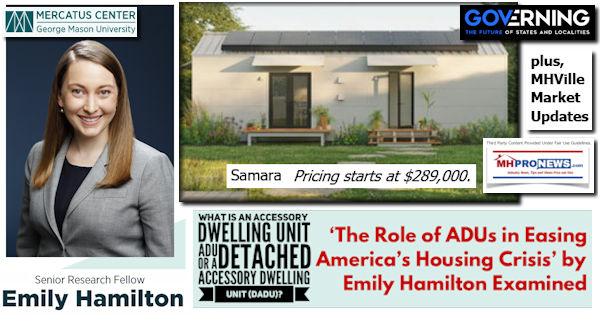
A recent article in Governing.com entitled “The Role of ADUs in Easing America’s Housing Crisis” by Emily Hamilton was published on 4.3.2023. Research such as the item linked here clearly indicates that interest and use of Accessory Dwelling Units (ADUs) or a Detached Accessory Dwelling Units (DADUs) are expanding in recent years. MHProNews has posts that reference ADUs going back over a decade. As interest in ADUs as part of a broader solution to the U.S. housing shortage appears to be growing, an overview that provides definitions and includes research by Hamilton and others appears warranted. Additionally, as the number of older Americans grow, some families are looking at ADUs or DADUs as a pragmatic – and often less expensive way – to keep an aging mom and/or dad nearby instead of in a nursing home or in some other kind of assisted living facility. Some manufactured housing or modular housing professionals think of an ADU in terms of prefabricated, factory-built or “off-site” built housing. But that is not always the case. Let’s note that every DADU is an ADU, but not every ADU is a DADU. That is so because garage and basement conversions, or add on construction, can be built on site and is thus an Accessory Dwelling Unit (ADU). Thus, most ADUs have historically not involved any factory building, the later of which are routinely detached forms of construction.
Building an ADU says: “Detached new construction ADUs, also sometimes called backyard cottages, granny flats, laneway houses, or DADUs, depending on the jurisdiction…” One of the builders of factory-built ADUs was featured in a report dated 2018 on Plant Prefab published on this platform and is linked below.
YIMBY, Amazon backed Plant Prefab Introducing ADUs, Product Video
With that brief introduction, a better understanding of Hamilton’s “The Role of ADUs in Easing America’s Housing Crisis” research can be appreciated.
According to her bio in brief, “…Hamilton is a Senior Research Fellow and Director of the Urbanity Project at the Mercatus Center at George Mason University. Her research focuses on urban economics and land-use policy… Hamilton received her PhD in economics from George Mason University.” Reading Hamilton’s article on ADUs never specifically mentions manufactured homes, modular housing, prefabs, factory building, or “off site” built new construction specifically. That said, she links to an article that does refer/imply some of those options.
Hamilton and Abigail Houseal co-authored an article on the Mercatus Center website dated March 30, 2023. It is entitled: “A Taxonomy of State Accessory Dwelling Unit Laws.” It includes a download, linked here, which mentions Ed Pinto and Tobias Peter, who are with the American Enterprise Institute (AEI) Housing Center. Pinto and Peter have been cited before in reports on MHProNews, such as the examples linked below.
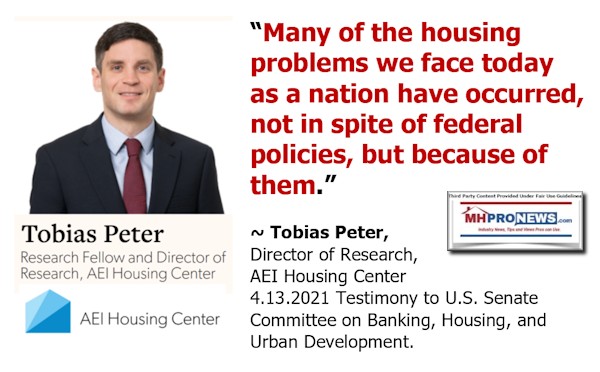
To underscore the value of the research by Pinto and Peter, their factual and evidence-based research and analysis methodology projected months in advance that the U.S. housing in several markets may go negative. That has since occurred in some parts of the country.
Per a Mercatus Center report: “Kol Peterson, a prominent ADU advocate, identifies three “poison-pill regulations” that present significant barriers to ADU construction, even in places where they are legalized. These poison pills include owner-occupancy requirements, off-street parking requirements, and conditional or discretionary reviews for ADU permits.”
As their collective research and other sources make abundantly clear, the underlying culprit limiting ADUs are often local zoning laws as well as state and federal policies. In that sense, ADUs and manufactured housing are in a similar, but not quite the same proverbial ‘boat.’
Hamilton and Houseal state in the research brief linked here: “Legalizing accessory dwelling units (ADUs) has been the most common way state policymakers have taken action to make more, lower-cost housing feasible to build.”
“ADUs are a secondary unit on a lot that includes a principal dwelling unit for one household. They can be a backyard cottage, a basement apartment, or a garage conversion, and most often they are added to single-family houses. To date, laws broadly allowing homeowners to build ADUs have passed in eight states, and ADU bills have been introduced in several others.”
According to Building an ADU: “In the twelve academic studies and professionally funded surveys that have been conducted on the presence of informal ADUs, they have all found that a whopping 10-20% of all the housing units in their study area are informal ADUs.” The article said: “Vast numbers of informal ADUs exist compared to permitted ADUs.” It also mused that: “Could 1/10th of all residential housing stock be informal ADU type development? That means there are more than thirteen million ADUs out there.” “There’s simply too few permitted ADUs to make a real difference in the housing stock. But, even if they aren’t going to solve all [of] a city’s problems, they may help homeowners solve some of their problems. ”
Hamilton stated in “The Role of ADUs in Easing America’s Housing Crisis” that: “Seniors are important for both the supply and demand of ADUs. Older homeowners are most likely to have the home equity or other savings to finance an ADU. Seniors are also particularly likely to be residents of an ADU on a family member’s property that facilitates intergenerational living.” That makes several relevant points, including the fact that financing is often an issue when considering an ADU of whatever type. More on that financing topic further below.
MHLivingNews and MHProNews have each brought to the attention of manufactured home industry readers and affordable housing advocates more broadly the research by Professor Daniel R. Mandelker.
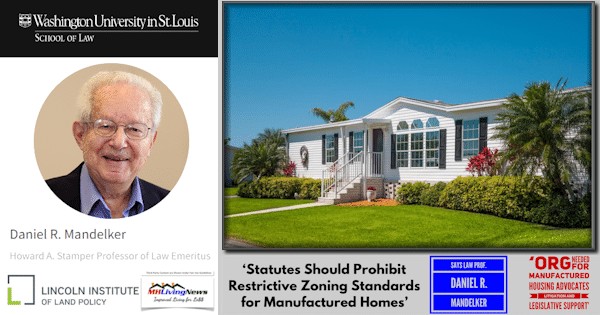
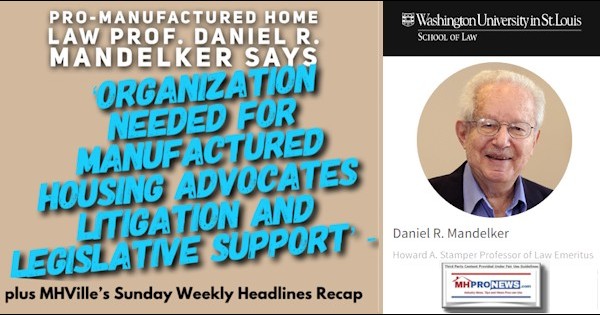
As a collection of articles by the above named and other sources linked here reflects, there are a wide range of costs to ADUs. In theory, perhaps the lowest cost for a DADU with full facilities would be a HUD Code manufactured home. The prefab DADU shown on the featured image is from an article linked here. A single section manufactured home could be purchased for 1/3rd of that cost, plus the costs for a crane, foundation and utility hookups. More on manufactured homes as ADUs in the attached collection of articles and further below.
A review of these various researchers, sources, and others of their kind often reveal the following.
- NIMBY vs. YIMBY tensions. NIMBY = Not in My Back Yard. YIMBY = Yes in My Back Yard. These catchphrases and acronyms reflect the various pressures on public officials from those who want more affordable housing (YIMBY) in specific areas vs. those who want to limit or bar such new construction (NIMBYs).
- The role that public officials play in the housing crisis.
- The part that financing plays in the housing crisis.
- Millions of housing units are needed. To its credit, Manufactured Housing Institute (MHI) member Cavco Industries (CVCO) recently cited the figure of 6 million housing units are needed nationally. MHProNews has for some years pointed out that there is an obvious disconnect between various claims on the actual number of housing units needed. Be it 6 to 8+ million housing units (more or less), it is apparent that public officials have failed for years in properly addressing the needs. What combination of special interests groups have thus far limited the response to the U.S. housing crisis, it would be important to note that it isn’t just single family homeowners who are often in the NIMBY camp. So too are often deep pocketed investors who invest in housing, and see value in limiting the number of units being built so as to boost the value of their holdings.
Near the end of this download, which ought to be considered a part of this report and analysis, is a segment on information from Freddie Mac. Freddie Mac, as regular and detail-oriented readers of MHProNews know, is one of the Government Sponsored Enterprises (GSEs) that is under the mandates enacted into law by Congress known as the Duty to Serve (DTS) Manufactured Housing, Rural and Underserved Markets. Manufactured housing uniquely falls into all three of those categories, because it is often in rural areas, and manufactured homes are most certainly needed in underserved markets. When some of the costs associated with ADUs are carefully examined, it quickly becomes apparent that manufactured homes would often be the far least expensive option. Manufactured homes as ADUs ought to be a clearly stated goal of every manufactured housing trade group.
That noted, Freddie Mac’s posted remarks on manufactured homes as ADUs include the following. Quoting:
- A manufactured home ADU has the same property eligibility requirements as any other ADU configuration. However, the manufactured home ADU must be titled as real property and meet HUD Code requirements. The appraiser must also provide additional property information specific to the manufactured home.
- When the subject property has a manufactured home ADU, does Freddie Mac require the appraisal report to include a comparable sale that also has a manufactured home ADU? No. The appraisal report should include at least one comparable sale with an ADU, when available. In all cases, the appraisal report must demonstrate that the ADU is marketable and includes supported adjustments that reflect the market’s reaction to the ADU. …
- Is a mortgage secured by a manufactured home that has a manufactured home ADU eligible for sale to Freddie Mac?A mortgage secured by a manufactured home with a manufactured home ADU is only eligible when the primary dwelling unit is a CHOICEHome®.
What is unstated, and what Freddie Mac has repeatedly failed when asked to specifically disclose, is how many MHI branded so-called CrossMod® homes – what Fannie Mae calls MHAdvantage® and what Freddie Mac calls a CHOICEHome® – have their been financed in total? Nor as MHI, Clayton Homes (BRK), Skyline Champion (SKY) or Cavco Industries (CVCO) been known to specifically disclosed that datapoint. In the case of Freddie Mac, going from federal disclosures, it seems that few – if any – CHOICEHome® loans have been originated. There are any number of reasons why this matters, which has been the topic of several reports on MHProNews and MHLivingNews. But what both evidence and common sense suggest is this. So few CrossMods have been built and financed that neither MHI, their so-called big three manufacturers, nor the GSEs themselves want to specifically highlight that data beyond what is absolutely required by the Federal Housing Finance Agency (FHFA) with respect to their DTS mandate under the Housing and Economic Recovery Act of 2008 (HERA). Without going to far afield in this report on ADUs, the illustration from Freddie Mac on manufactured housing and ADUs ought to be one more example of why MHI and/or their big three builders ought to end what a big three builder said to MHProNews was a program with ‘no traction.’
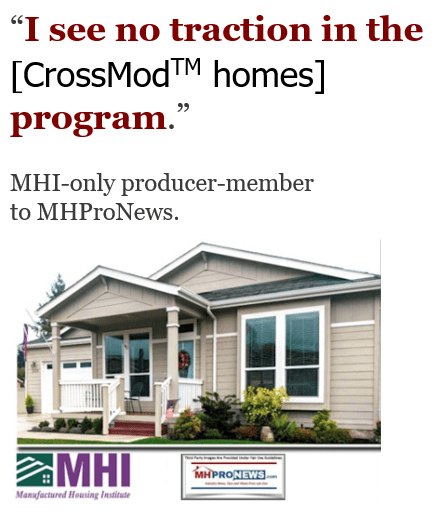
To sum up the relevant segue on CrossMods before moving toward a conclusion on ADUs, the following points should be made.
- By giving so much attention to CrossMods – which has every indication of being a market failure – MHI and its big three builders have arguably undermined much of the balance of manufactured housing. Be that accident and/or by design, it is indicative of the lack of trustworthiness that those leaders merit. Recall that MHI and their leaders have early on, and more recently too, touted CrossMods as a big part of the future of the industry. If the results to date – which may total fewer than 100 units financed nationally ever since the scheme was first announced – are any indication, it is a clear indication that MHARR and the Modular Home Building Assocation’s Tom Hardiman have each made apt warnings about the project.
- MHI ought to repent – that term is used with good reason – of their involvement in this arguably failed project – and move instead toward properly promoting all HUD Code manufactured homes.
- There has been ‘residential style’ manufactured homes for decades. They long predate CrossMods. It has been counterintuitive from the beginning to create a new and untested classification for a kind of manufactured home when millions of HUD Code homes have already been sold.
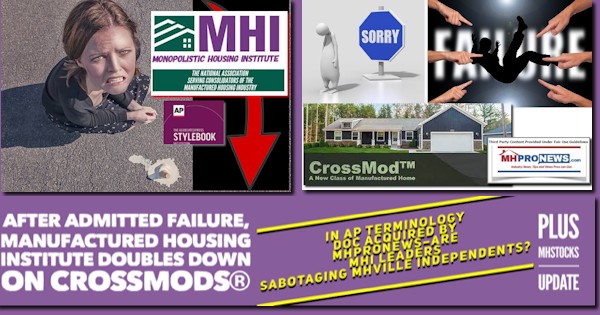
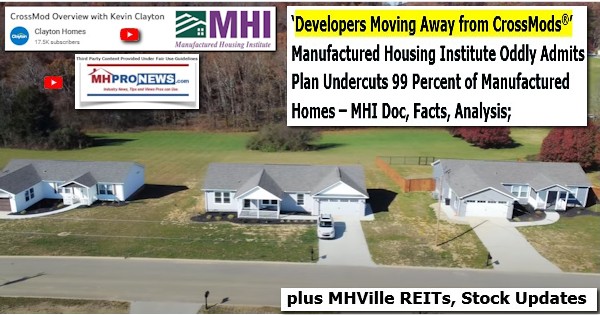
MHI and its leading brands appear to either have been engaging in a campaign for CrossMods that could be fairly described as one made up of smoke and mirrors. CrossMods may be ‘real’ – as the Texas A&M Real Estate Research Center (TRERC) said – but there is only marginally more evidence for them than there is for Sasquatch. Indeed, if photos, videos, articles and social-media posts are the test, one might surmise there is more evidence for Bigfoot (a.k.a. Sasquatch) than for CrossMods. But you won’t likely get that evidence-based insight and analysis from a pro-MHI aligned website.
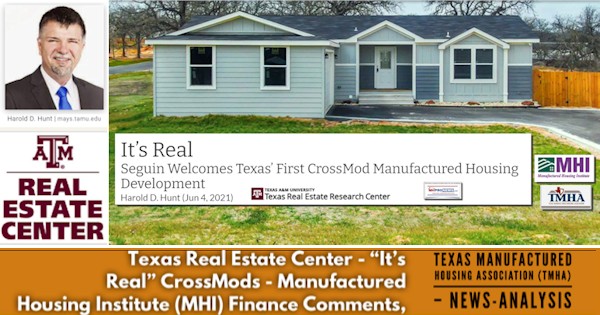
ADUs – or perhaps more properly, DADUs – is an arena that manufactured housing could be engaged with in a profitable and market-expanding level. But where is the similar effort to promote ADUs by MHI than there are for CrossMods?
The Preemption Issue
What Hamilton and Houseal have demonstrated is that state-based preemption is an important and valuable tool in the battle for ADUs. As MHProNews noted over two years ago, the experience evolving in California and the expanding number of ADUs being deployed there, why hasn’t federal preemption for HUD Code manufactured homes been pragmatically pressed by MHI to expand the industry’s options in ‘back yard’ housing?
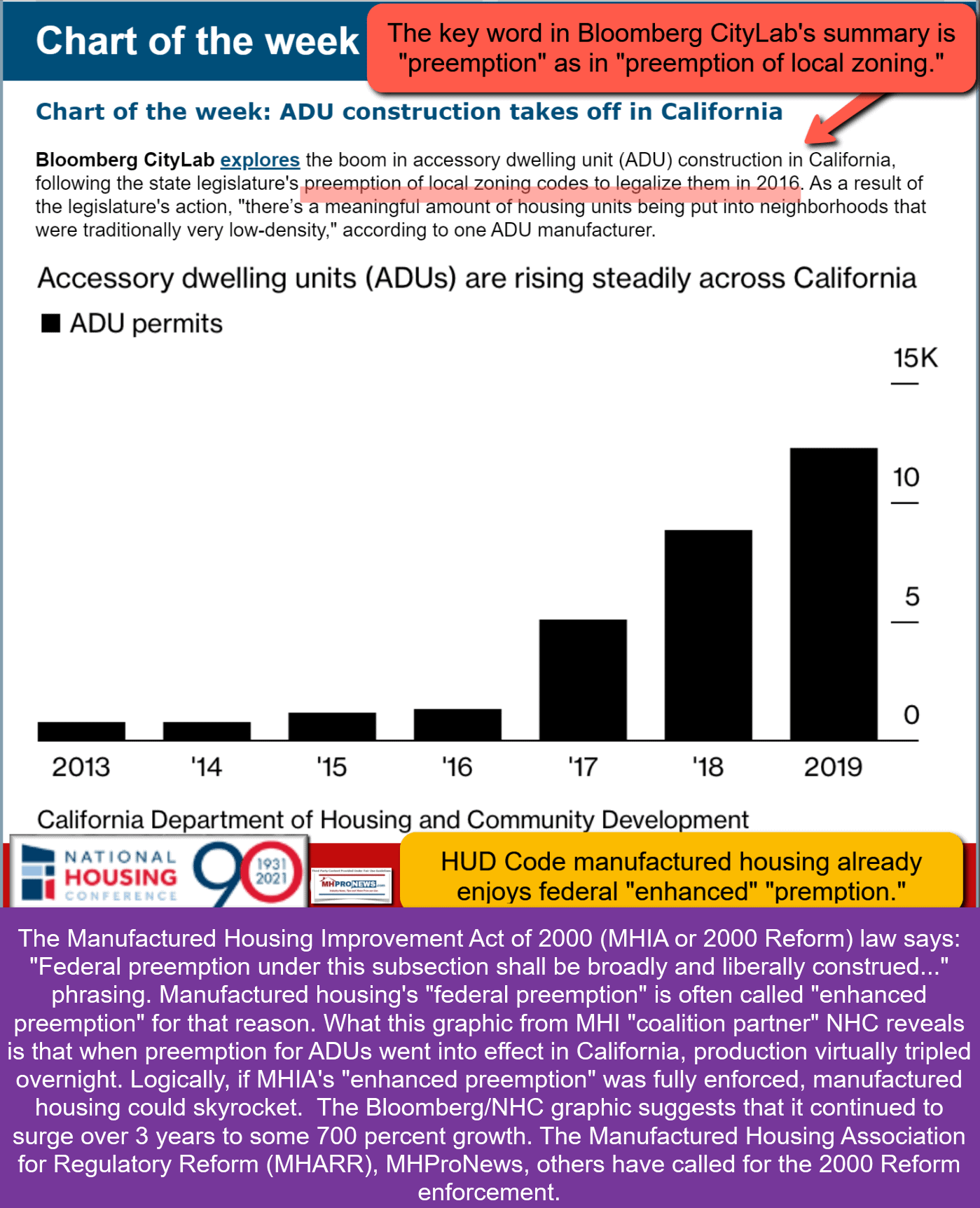
Based solely on the two articles referred to herein by Hamilton, there is no clear indication of the notion of federal manufactured housing “enhanced preemption” claimed by MHI, the Manufactured Housing Assocation for Regulatory Reform (MHARR), or others involved in HUD Code manufactured housing. Zoning and placement are post-production issues. That puts it squarely in the arena of MHI, which claims to represent “all segments” of manufactured housing and ‘factory-built housing.’ MHARR has noted that they are involved in this issue in part because of MHI’s apparent failure to achieve the implementation of the enhanced preemption issue.

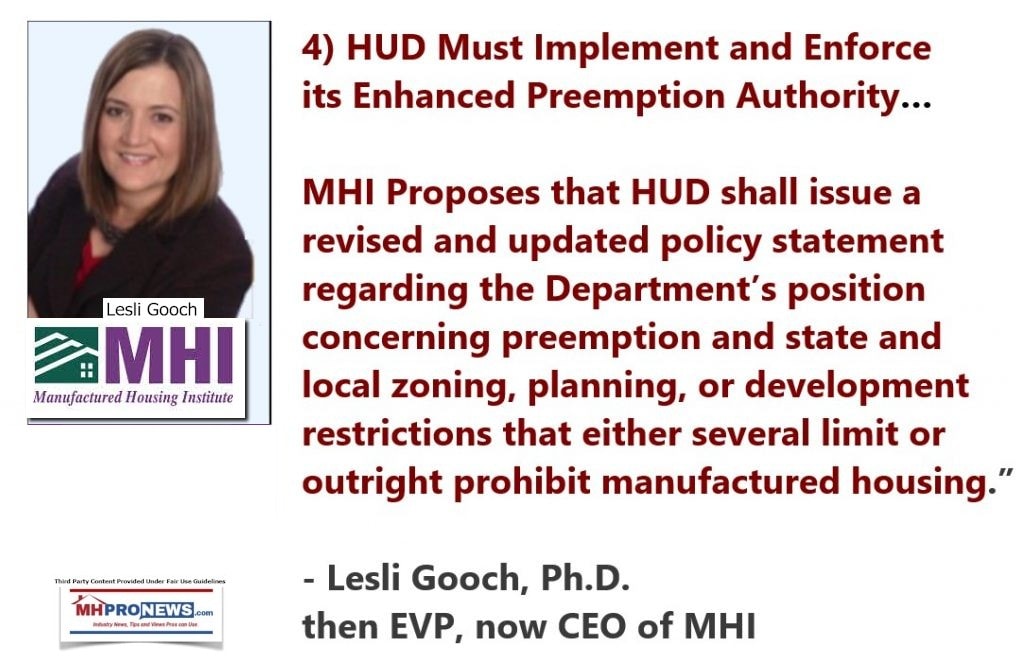
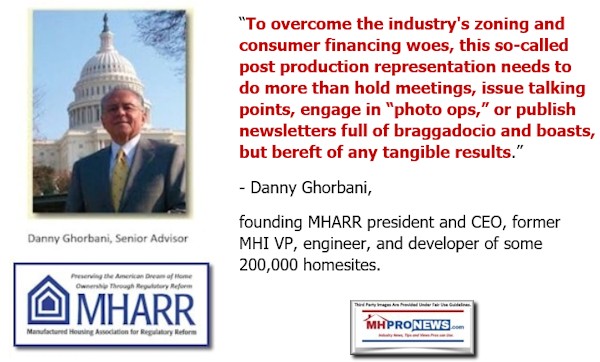
By way of analogy, MHI has touted in several of their recent emails ‘news’ updates to members that they have had a ‘multipronged’ approach to the DOE energy rule issue.
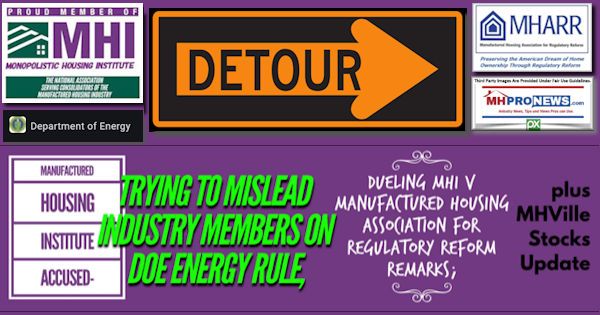

That being said, why hasn’t MHI deployed an authentic and rigorous multipronged effort to get enhanced preemption enforced for ALL sizes and styles of HUD Code manufactured homes? If they did that, and maybe wanted to keep CrossMods as a subcategory of all manufactured homes, let individual manufacturers do so. But to seemingly press more for a failed product and by extension to that extent ignore the federal preemption that Congress arguably granted with the passage of the Manufactured Housing Improvement Act of 2000 (MHIA) makes very little sense.
The emerging ADU/DADU story is that state preemption can work. But that was the logic behind the industry pressing for federal “enhanced preemption.”
- As a planned future report may explore, there are tens of thousands of opportunities within cities across the country that have vacant lots that could be the future homesite for an affordable HUD Code home.
- There are potentially millions of opportunities to do DADU style ADUs in the backyards of site-built housing in every state and possibly Washington, D.C. too.
- The discussion of ADUs should ideally routinely include some mention of manufactured housing. But as the attached articles reflect, that is often not the case. Isn’t that an obvious failure on MHI’s part to make federal enhanced preemption for HUD Code manufactured homes a high-visibility and high-priority goal to achieve and not just occasional and less than ideally written op-ed about?
Cavco Industries aptly noted that a lack of affordable housing near where it is needed is costing the U.S. economy some $2 trillion dollars a year. The report linked below includes links to prior research that MHProNews has highlighted for the industry’s readers that used that same estimate – $2 trillion dollars in lost annual GDP – caused by the current status quo.
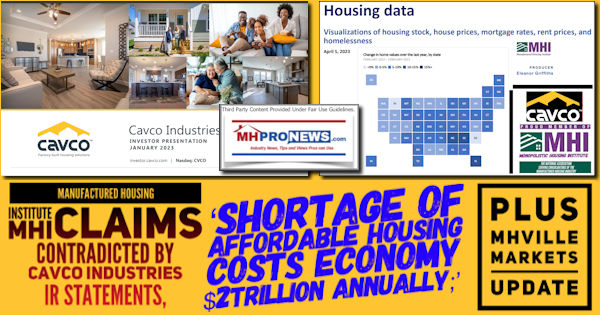
Each of the articles attached to this report, by Hamilton and others, make insightful and useful information about ADUs. But what is apparent from those same articles is how seldom manufactured homes are mentioned, even if prefab or modular housing is.
Doing the math, $2 trillion in lost GDP is about like $6,000 per person per year. One lesson to be learned is that there are any number of ways that the case for ADUs and the case for manufactured homes could be advanced side-by-side. Certainly, modular and other forms of prefab housing merit their proper place in that mix, as should conventional construction.
Summary, Takeaways and Conclusion
What this reasonably focused report and analysis has once again illustrated is that MHI keeps missing the mark. But as or more important, there are an array of opportunities for manufactured housing to advance. Sincere MHI supporters need to press MHI’s leadership to effectively do what they already claim to want.

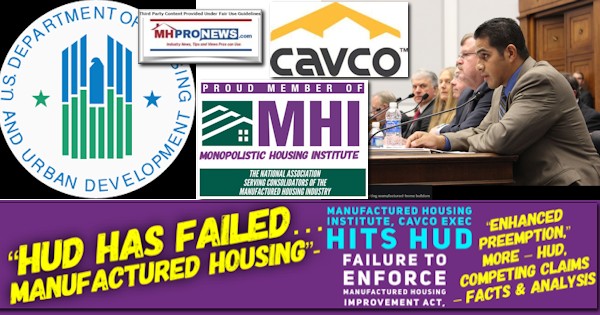
Part II Daily Business News on MHProNews Markets Segment
The modifications of our prior Daily Business News on MHProNews format of the recap of yesterday evening’s market report are provided below. It still includes our signature left (CNN Business) and right (Newsmax) ‘market moving’ headlines. The macro market moves graphics will provide context and comparisons for those invested in or tracking manufactured housing connected equities.
In minutes a day readers can get a good sense of significant or major events while keeping up with the trends that are impacting manufactured housing connected investing.
Reminder: several of the graphics on MHProNews can be opened into a larger size. For instance: click the image and follow the prompts in your browser or device to OPEN In a New Window. Then, in several browsers/devices you can click the image and increase the size. Use the ‘x out’ (close window) escape or back key to return.

Headlines from left-of-center CNN Business – from the evening of 4.19.2023
The headline capture for CNN and Newsmax failed yesterday. MHProNews regrets the error and any inconvenience.
Notice: the graphic below can be expanded to a larger size.
See the instructions below the graphic below or click the image and follow the prompts.
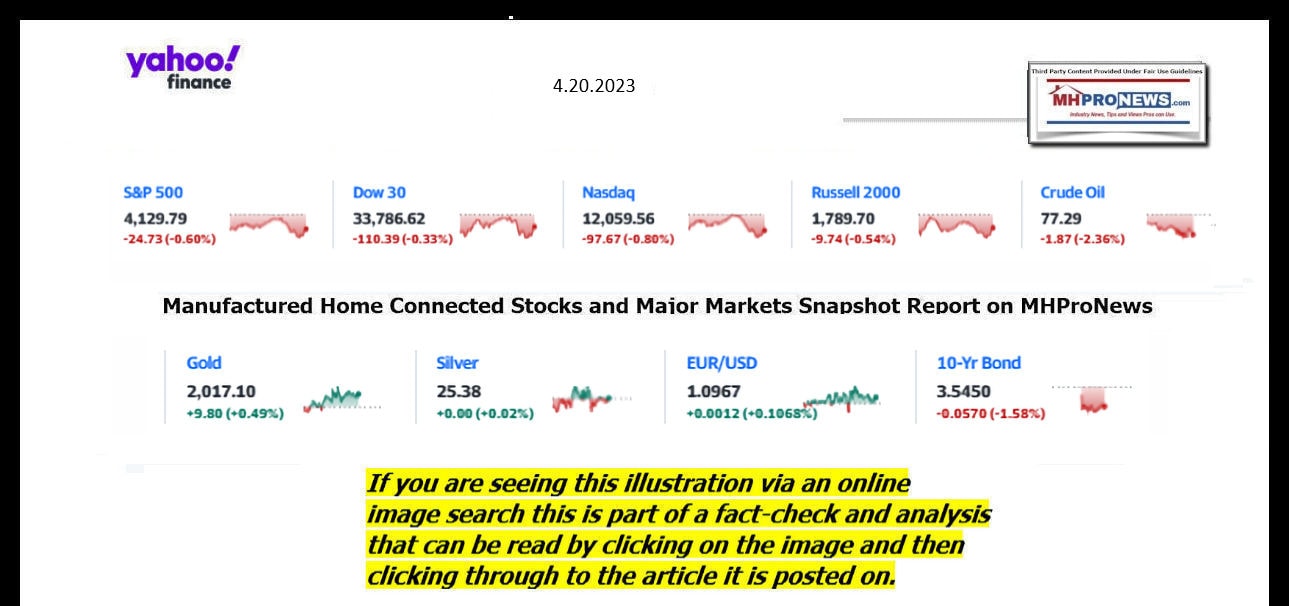
Notice: the graphic below can be expanded to a larger size.
See the instructions below the graphic below or click the image and follow the prompts.
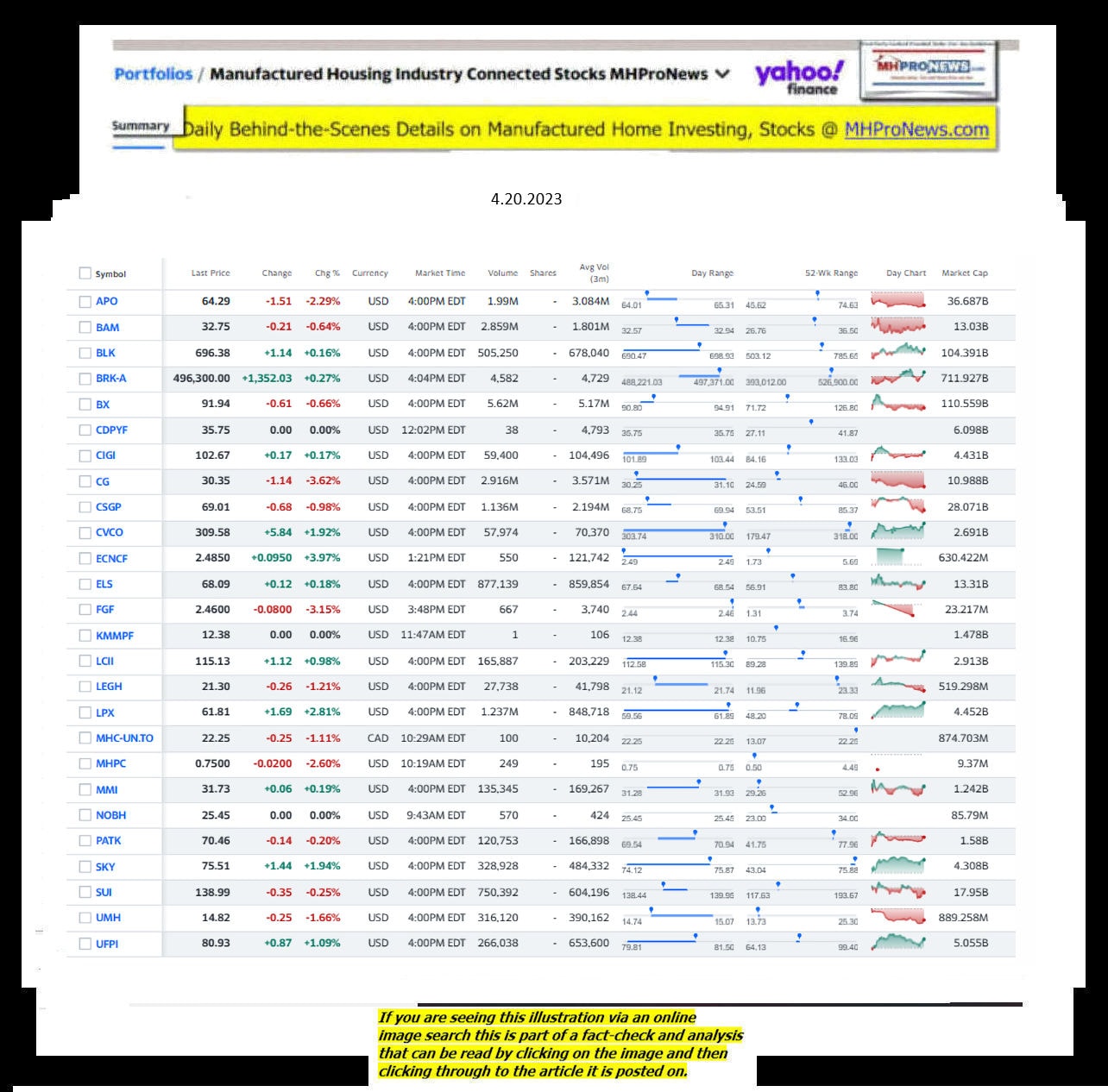
Headlines from right-of-center Newsmax 4.20.2023
The headline capture for CNN and Newsmax failed yesterday. MHProNews regrets the error and any inconvenience.
2022 was a tough year for many stocks. Unfortunately, that pattern held true for manufactured home industry (MHVille) connected stocks too.
See the facts, linked below.
====================================
Updated
-
-
- NOTE 1: The 3rd chart above of manufactured housing connected equities includes the Canadian stock, ECN, which purchased Triad Financial Services, a manufactured home industry finance lender.
- NOTE 2: Drew changed its name and trading symbol at the end of 2016 to Lippert (LCII).
- NOTE 3: Deer Valley was largely taken private, say company insiders in a message to MHProNews on 12.15.2020, but there are still some outstanding shares of the stock from the days when it was a publicly traded firm. Thus, there is still periodic activity on DVLY.
- Note 4: some recent or related reports to the REITs, stocks, and other equities named above follow in the reports linked below.
-



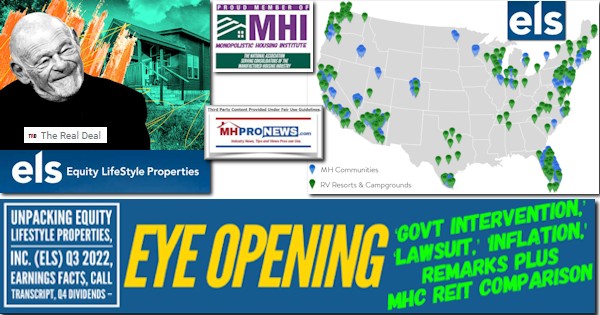
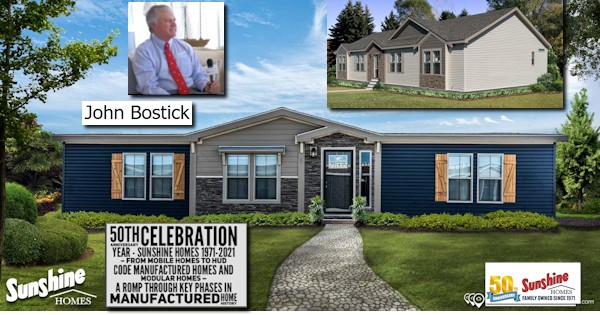
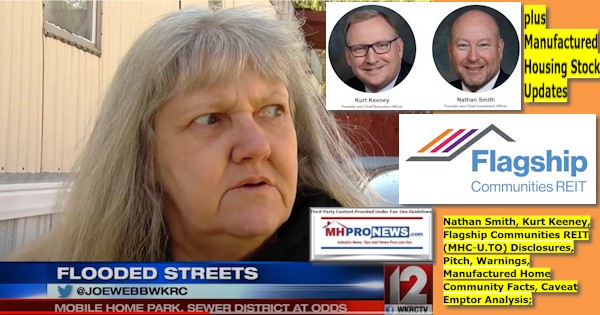
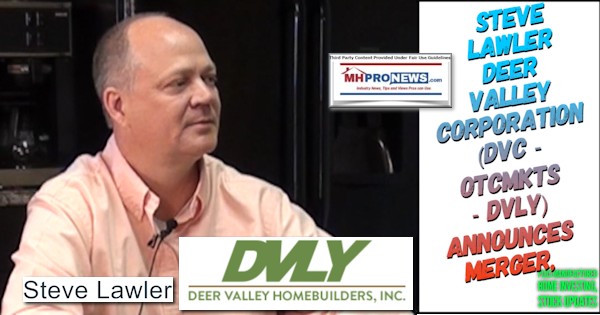
2023 …Berkshire Hathaway is the parent company to Clayton Homes, 21st Mortgage, Vanderbilt Mortgage and other factory-built housing industry suppliers.
· LCI Industries, Patrick, UFPI, and LP each are suppliers to the manufactured housing industry, among others.
· AMG, CG, and TAVFX have investments in manufactured housing related businesses. For insights from third-parties and clients about our publisher, click here.
Disclosure. MHProNews holds no positions in the stocks in this report.
· For expert manufactured housing business development or other professional services, click here.
· To sign up in seconds for our industry leading emailed headline news updates, click here.


That’s a wrap on this installment of “News Through the Lens of Manufactured Homes and Factory-Built Housing” © where “We Provide, You Decide.” © (Affordable housing, manufactured homes, stock, investing, data, metrics, reports, fact-checks, analysis, and commentary. Third-party images or content are provided under fair use guidelines for media.) (See Related Reports, further below. Text/image boxes often are hot-linked to other reports that can be access by clicking on them.)

By L.A. “Tony” Kovach – for MHProNews.
Tony earned a journalism scholarship along with numerous awards in history. There have been several awards and honors and also recognition in manufactured housing. For example, he earned the prestigious Lottinville Award in history from the University of Oklahoma, where he studied history and business management. He’s a managing member and co-founder of LifeStyle Factory Homes, LLC, the parent company to MHProNews, and MHLivingNews.com. This article reflects the LLC’s and/or the writer’s position and may or may not reflect the views of sponsors or supporters.

























